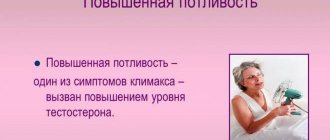PMS is a kind of combination of physical, emotional and psychological changes in the female body that occur no earlier than two weeks before the start of menstruation and subside a few days after that.
Although three out of four mature women experience symptoms of premenstrual syndrome, the changes caused by hormonal fluctuations at different phases of the monthly cycle are confusing. When symptoms are severe and interfere with normal activities, there are treatments that can help relieve symptoms before starting treatment.
One of the causes of premenstrual syndrome is changes in the levels of estrogen and progesterone over a certain period of time, with estrogen playing a dominant role in this.
Another important cause is an imbalance in serotonin mediation. Low levels of serotonin affect a woman's emotional state, causing frequent and sudden mood swings, decreased libido, depressive episodes, anxiety, irritability, insomnia and lack of appetite.
Physical changes that occur during premenstrual syndrome include headache, fatigue, acne, abdominal pain, constipation or diarrhea, painful and tender breasts, and swelling due to fluid retention.
Before resorting to medication, there are several methods that can help ease both these and emotional changes.
Interesting facts about premenstrual syndrome
— The term “PMS” was first used by British gynecologist Robert Frank in 1931.
— Women whose activities involve mental work and residents of large cities suffer more from the symptoms of premenstrual syndrome.
- Crime days. PMS is not only a disgusting mood and moral bullying of a spouse. Most thefts, crimes and accidents are committed by women after the 21st day of the menstrual cycle, at the very “peak” of premenstrual syndrome.
- Shopaholic. Research confirms that a few days before their period, girls are much more willing to part with money and are more susceptible to the temptation of shopping addiction.
What causes the development of PMS?
It is impossible to say exactly how many days before your period PMS begins, how and how long it lasts. There are also many different versions of the development of the syndrome, but there is no exact data on why it develops in a particular patient. This is due to the fact that women live in an intense rhythm, work a lot, and have constant stress and physical activity.
The development of the syndrome is also influenced by:
- infectious diseases;
- decreased immunity;
- mental stress;
- traumatic brain injuries;
- inflammatory diseases of the genitourinary area.
Unwanted pregnancies that are terminated also play a role. All these factors contribute to the development and worsening of premenstrual tension.
However, doctors have proven that these manifestations directly depend on disturbances in the activity of the hypothalamus, the center of the brain that regulates the menstrual and endocrine function of a woman. Therefore, the main goal of PMS therapy is to normalize the functioning of this part of the brain.
Causes of premenstrual syndrome
There are many theories about the causes of ailments before menstruation - psychosomatic, allergic, hormonal. The most popular is the hormonal theory. According to this theory, strong fluctuations in sex hormones begin in the second phase of the menstrual cycle.
For the full functioning of the female body, the balance of sex hormones - progesterone, androgen and estrogen - is very important. During premenstrual syndrome, the hormonal background of the female body undergoes dramatic changes. Symptoms of PMS appear due to an incorrect reaction of the body to changes in hormonal levels.
The parts of the brain responsible for emotions and behavior begin to respond inadequately to hormonal changes. This entails a whole load of somatic and mental symptoms. Symptoms depend not so much on the level of hormones, but on the reaction of the limbic parts of the brain to these fluctuations.
What you need to know about periods in teenagers
Teenagers' periods are part of the menstrual cycle. The menstrual cycle is a series of hormonal and physical changes in the body that prepare the body for pregnancy. If pregnancy does not occur, the body returns to its original state and a new menstrual cycle begins.
The duration of the menstrual cycle is measured from the beginning of one period to the beginning of the next. The average menstrual cycle lasts about 28 days. A cycle that is one week longer or shorter is still considered normal. Menstrual bleeding in teenagers usually lasts from three to five days, but for some girls it may vary from two to five days. The average volume of blood loss during one period in adolescents is 35-80 ml; normally, a pad or tampon should last for 3-4 hours.
During the first two years of adolescents' first period (menarche), their menstrual cycle may be irregular and unpredictable. In adolescents, the menstrual cycle is often anovulatory. This means that the egg may not be released. It takes up to two years for girls to establish a normal menstrual cycle, and regular ovulation appears even later. This does not mean that teenagers are infertile. This means that it is not known in which cycle ovulation occurs and in which it does not.
During the menstrual cycle, there are constant changes in the levels of hormones, the lining of the uterus and the egg. The following main points can be highlighted.
- Menstruation (menstruation). In a teenager, the inner lining of the uterus (endometrium) is shed, accompanied by bleeding. Periods indicate the beginning of the menstrual cycle. Their duration varies from girl to girl; it is largely related to the length of the cycle itself.
- Follicular phase. At this time, the ovaries are stimulated to produce a mature egg, which matures in one of their follicles. The endometrium thickens in preparation for the possible implantation of a fertilized egg in the event of pregnancy. The predominant hormones of this phase are estrogens.
- Ovulation. This is the release of a mature egg from the ovaries under the influence of luteinizing hormone.
- The luteal phase of the cycle lasts from ovulation until your next period. The endometrium continues to grow in preparation for embryo implantation. The follicle from which the egg was released turns into a temporary gland that produces the hormone progesterone. If pregnancy does not occur, a new menstrual cycle begins.
What factors aggravate the course of premenstrual syndrome?
There are a number of factors that provoke the development of PMS symptoms:
1. Magnesium deficiency – a lack of magnesium can cause dizziness, headache, and rapid heartbeat. With a lack of magnesium in the body, a woman is strongly drawn to chocolate.
2. Lack of vitamin B6 - leads to fatigue, weakness, swelling, sudden mood swings and breast tenderness.
3. Smoking – women who smoke are twice as likely to suffer from symptoms of premenstrual syndrome.
4. Overweight – women with a body mass index greater than 30 are three times more likely to suffer from PMS symptoms.
5. Low levels of serotonin - a lack of the “hormone of joy” causes sadness, melancholy, tearfulness and a depressive mood.
6. Heredity - girls whose mothers suffered from premenstrual syndrome run the risk of inheriting it.
7. Difficult childbirth, abortion, gynecological diseases and stress often lead to the appearance of PMS.
Physical activity and sleep
Physical activity at least 3 times a week is not only beneficial for negative pre-period symptoms, but also for overall physical and mental health. This is due to the release of endorphins, which reduce irritability.
If even lifestyle changes do not improve symptoms before monthly bleeding, and they are too severe to limit you in your daily life, it is recommended to consult a specialist. Gynecologists usually prescribe the following groups of drugs:
- Non-steroidal drugs - suppress the synthesis of prostaglandins and, thus, have an anti-inflammatory and analgesic effect. NSAIDs, such as aspirin, paracetamol, ibuprofen, relieve stomach cramps and headaches.
- Diuretics. Spironolactone blocks aldosterone receptors, which leads to increased diuresis and natriuresis - aldosterone usually stimulates sodium reabsorption and potassium secretion. It is extremely important that diuretics are not combined with non-steroidal anti-inflammatory drugs, as they aggravate renal activity, and in patients with impaired renal function, the risk of developing renal failure increases!
- Contraception – In addition to providing contraceptive effects, combination contraceptive medications relieve premenstrual symptoms due to blockade of ovulation.
- Selective serotonin reuptake inhibitors. Prescribed for very severe premenstrual syndrome, treatment with antidepressants such as fluoxetine, paroxetine, sertraline may be required. SSRIs increase serotonin levels and relieve depressive episodes during PMS.
In conclusion, to relieve premenstrual syndrome, lifestyle changes are necessary, and when this is not enough and premenstrual pain is severe, consultation with a specialist is necessary to prescribe appropriate therapy.
ONLINE REGISTRATION at the DIANA clinic
You can make an appointment by calling the toll-free phone number 8-800-707-15-60 or filling out the contact form. In this case, we will contact you ourselves.
If you find an error, please select a piece of text and press Ctrl+Enter
Symptoms of premenstrual syndrome
Premenstrual syndrome is very rich in completely different, dissimilar symptoms. All these symptoms can be divided into several groups:
- neuropsychiatric - the most common group of symptoms. Women's mood often changes during this period - the desire to cry is replaced by the desire to blow up the whole world. Many girls become irritable, nervous, and anxious. Apathy, sadness, melancholy appear. Some suffer from insomnia and depressed mood.
- vegetative-vascular - headache, dizziness, pressure surges, pain in the heart, nausea, vomiting, rapid heartbeat, disruptions in the gastrointestinal tract.
- endocrine - fever, swelling, frequent urination, thirst, belching, bloating, breast tenderness, itching, acne, feeling of lack of air, decreased attention and memory.
Some women may experience slight weight gain. This occurs due to fluid retention in the body. Sometimes PMS symptoms can manifest themselves in the form of crises and attacks - a woman experiences attacks with increased blood pressure, frequent urination, dizziness, pain in the heart and a feeling of severe anxiety and fear, that is, with typical signs of a panic attack.
Teenage PMS
Premenstrual syndrome is not always just an adult problem. Teenage girls can also encounter it. What features does young PMS have? What do mothers need to know to help their daughters?
An obstetrician-gynecologist from the St. Petersburg Research Institute of Obstetrics and Gynecology named after. D. O. Otta Tatyana Mikhailovna Lekareva.
In general, Premenstrual syndrome is quite rare during the first menstruation. Much more often, malaise appears when the cycle becomes regular. This usually takes about 6-12 months. But sometimes premenstrual syndrome is still detected almost from the first cycle. In this case, it’s worth thinking about. After all, the early appearance of PMS is a warning sign. It indicates that the problem will worsen over the years. Therefore, you need to act very quickly. We need to take our daughter to a gynecologist so that he can prescribe an examination and then treatment. The difficulty is to identify the problem in time. Unfortunately, teenage PMS is often carefully disguised.
Suspicious swelling Sometimes PMS manifests itself as swelling. In the second half of the cycle, too much water accumulates in the body. The breasts increase in size and begin to hurt. But this is not conclusive evidence of PMS. Indeed, during puberty, girls very often complain of pain in the growing mammary glands, and this is absolutely normal. Therefore, you need to pay attention to other signs, such as an enlarged abdomen. It is noticeable when trousers or skirts become too small. Girls react differently. Some go on a diet, others ask their parents to buy new clothes. Both should make the mother think and talk with her daughter. She will most likely complain of weight gain. Upon more detailed questioning, it will most likely turn out that the most problematic area is the stomach. Hips, buttocks, shoulders - their sizes hardly change. But the waist increases so much that it is difficult to fasten the zipper. If such metamorphoses occur in the second half of the menstrual cycle, then you should go with your daughter to a gynecologist.
Problems at home and at school Mom should think about it if her daughter’s character has changed dramatically. Of course, adolescence itself leaves its mark. Girls become irritable, categorical and even aggressive. Recognizing PMS is very difficult, but still possible. A calm and balanced child suddenly becomes rude and intolerant, and this happens in the second half of the cycle. And with the onset of menstruation, the girl calms down, and her character does not seem to change. If such transformations are observed over several months, then perhaps it is PMS. Another tip for mothers is their daughter’s school diary. The fact is that PMS has a bad effect on a child’s performance and performance. It becomes more difficult for him to study. Concentration, perseverance, and memory decrease. All this, of course, is reflected in the ratings. In the second half of the cycle they become worse. If there is such a tendency, this is again a reason to contact a gynecologist.
Every day calendar A special diary, which is kept for at least two months, helps to diagnose PMS.
It is a table. Days are marked in the horizontal graphs, and signs of PMS are noted in the vertical graphs. Among them are irritability, pain in the mammary glands, swelling, and tearfulness. In total, at least ten signs are collected. Their severity is measured in points. Every day the girl fills out her diary. Then the overall picture is assessed. If in the second half of the cycle the number of points increases sharply, it means there is PMS. In this case, treatment is selected. Some people are helped by herbal teas, massage and acupuncture. Others need more serious correction - then diuretics and medications that affect the metabolism of certain substances come to the rescue. In some cases, they resort to hormonal drugs. In a word, doctors have quite a lot of ways to treat PMS in their arsenal. You just need to take action in time. Yana IVOLGA
When to see a doctor
Of course, if the symptoms of premenstrual syndrome cause only minor discomfort, you can cope on your own. But when PMS disrupts the quality of life and affects the ability to work, you cannot do without contacting a gynecologist. After the examination, the doctor will prescribe the necessary drug therapy and give recommendations.
Depending on the symptoms, the following are prescribed for PMS:
- homeopathic medicines to relieve the syndrome;
- non-steroidal anti-inflammatory drugs - for back and abdominal pain, headaches;
- antidepressants and tranquilizers - for severe mental disorders;
- diuretics - for edema;
-hormonal therapy – in case of imbalance of sex hormones.
What are the symptoms and signs before menstruation?
Manifestations of PMS are familiar to many women. It is not the bleeding itself that brings suffering, but rather the unsatisfactory condition before menstruation.
The reason is known to doctors - these are hormonal changes that affect the functioning of the nervous system and some organs. Therefore, women become depressed, complain of headaches and become irritable.
Today we will tell you by what signs the premenstrual period is recognized.
Prevention
To prevent the manifestation of premenstrual syndrome, a woman must exclude:
- excessive consumption of salt, alcohol, caffeine;
- uncontrolled use of COCs (combined oral contraceptives);
- sudden climate change;
- stress and emotional overload;
- increased physical activity.
Aerobics, yoga, meditation and relaxation are recommended. To maintain emotional stability and performance, take vitamins E, B6, calcium and magnesium.
The prognosis for PMS is largely favorable, but in the absence of treatment or non-compliance with recommendations, a relapse of the disease is possible. The prognosis for patients over 40 years of age is questionable; in especially severe cases, they are recommended to undergo oophorectomy - a surgical operation to remove the ovaries and subsequent estrogen therapy. In the video about what premenstrual syndrome is and how to alleviate your condition:
Diagnostics
Most often, pathology is diagnosed based on complaints and examination of the patient. Doctors pay attention to the fact that these complaints are repeated with a certain frequency, that is, every month in the second half of the menstrual cycle, closer to menstruation.
Due to the fact that the manifestations of the syndrome are varied, diagnosis is often difficult. In this situation, it helps to keep the patient a kind of menstrual diary, where all the symptoms and the time of their manifestation are recorded.
Patients may be prescribed other examinations to exclude various diseases:
- X-ray of cerebral vessels;
- encephalography;
- blood hormonal study;
- study of renal excretory function;
- determination of the condition of the fundus.
For the psycho-emotional form of PMS, consultation with a neurologist and psychiatrist is recommended.
Premenstrual tension is differentiated from the following diseases:
- migraine;
- renal dysfunction;
- arachnoiditis;
- hypertension;
- brain tumors.
Hormonal stability
The natural approach to hormonal fluctuations is different. It does not seek to eliminate hormonal fluctuations; instead, they are perceived as a normal and beneficial process. Your hormones fluctuate, so they are produced within the cycle in which ovulation occurs. This is the only way to create them. Let's put it this way: if hormones are produced, they will fluctuate. No need to balance hormones. You just need to be able to adapt to their ups and downs. This ability to adapt to hormonal fluctuations is what I call hormonal resilience. New research supports the idea of hormonal resistance and suggests a genetic component. The cells of women with premenstrual dysphoric disorder (PMDD) respond differently to hormones compared to women who do not experience the condition.
PMDD (Premenstrual Dysphoric Disorder) is a condition of severe premenstrual depression, irritability, or anxiety. Occurs in approximately one in twenty women.
So perhaps you were lucky enough to be born with genes that protect you from premenstrual symptoms. If not, you can protect yourself by developing hormonal stability in three simple steps:
- Increase your progesterone and GABA levels.
- Stabilize estrogen and metabolize it properly.
- Reduce inflammation to calm your hormonal and neurotransmitter receptors.
Did you notice the third point? Reduce inflammation. Why is this so important for PMS?
How to relieve PMS yourself?
If PMS is mild, you can try to cope with the disease on your own. For this, doctors recommend:
- proper and rational nutrition;
- eat in small portions, but often;
- reduce salt intake;
- give up coffee, alcohol and cigarettes;
- the diet should contain foods rich in calcium (cottage cheese, milk, hazelnuts, sesame seeds), complex carbohydrates (fruits, vegetables and whole grains);
- physical activity is required (walking, swimming, yoga, aerobics, etc.);
- avoid stress;
- follow the regime, sleep more.











